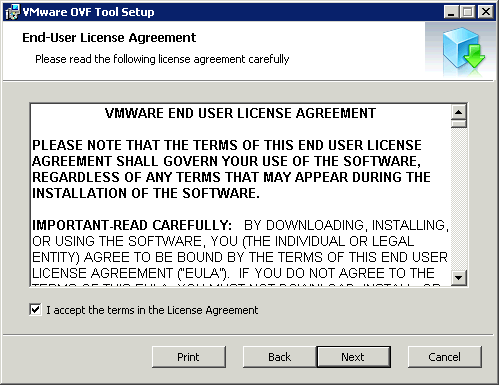- Vmware software download, free
- How To Use Ovf Tool
- Vmware Ovf Tool Download
- Vmware Ovf Tool Download 64-bit
There are many organizations running multiple environments such as Test, Development, Stage, and production. Usually all the developments and deployments start with the Test or Development environment. Once the deployment or POC is completed in the lower environment, they want to move the deployment on a higher environment such as Stage or Production.
Download the OVF Tool for Windows based on your operating system platform—whether it is a 32-bit or 64-bit platform—from the VMware website. In my case, the Windows operating system is 64-bit, and I have downloaded the OVF Tool.msi file. Double-click on the downloaded.msi file to start the installation. OVF Tool User's Guide 10 VMware, Inc. Using the VMware OVF Tool The VMware OVF Tool is available on many platforms and can be downloaded if not built into a product. VMware Platforms Using the OVF Standard VMware supports the OVF standard on the following platforms. Print Back Download Zip. Display Table of Contents. Table of Contents About This Book Overview of the OVF Tool The Open Virtualization Format The OVF Standard. Run VMware OVF Tool From the Command Line Run OVF Tool With ESXi and vCenter Target Locations Deploy a Virtual Machine to.
When the deployment is moving towards the higher environment, the product team wants the same thing configured with the test & dev environment to the higher environment. It will waste a lot of effort if you are re-doing the things from scratch in the upper environments such as stage or production. Most of the dev team requesting us to clone or copy the dev VM's to stage or production environment.
What would the vSphere administrators do?
Environments have direct connectivity, we can clone the virtual machines directly between vCenter Server using Cross-vCenter VMotion.
Cross-vCenter vMotion feature requires enterprise plus license. You can use the tools like Cross vCenter Workload Migration Utility to clone or migrate the VM's across the vCenter Servers between the environments.
Take a look at my article on how to vMotion VM's between vCenter Servers using Cross vCenter Workload migration utility.
What if you don't have the enterprise plus license and direct connectivity between the environment?
The easiest option is to export the virtual machine to OVF using the 'Export OVF Template' option in the vCenter Server and import the OVF into virtual machines in the new environment.
Specify the Name for the OVF template and click Ok.
I noticed the timeout errors when export the VM as OVF from vCenter Server especially for larger VM's. To avoid the timeout issue, I used to export VM to OVA or OVF using OVF Tool. In this article, I will explain with the detailed procedure to export VM to OVA or OVF using OVF Tool.
We have also discussed converting OVA to the OVF file using OVF Tool in one of the earlier blog posts. Check out: How to convert OVA to OVF using OVF Tool
Vmware software download, free
How to Export VM to OVA or OVF using OVF Tool?
My goal today is to help you learn about:
- How to Download and Install VMware OVF Tool?
- How to Discover the VM Path using the OVF Tool?
- How to Display the VM OVF details OVF Tool?
- How to Export VM to OVA using OVF Tool?
- How to Export VM to OVF using OVF Tool?
Download and Install VMware OVF Tool
Before We understand how to Export VM to OVA or OVF using OVF Tool, Let's understand where to download and how to install the VMware OVF Tool. OVF Tool installer is available for Windows, Linux and MAC OSX.
You can download the VMware OVF tool from VMware Website.
For this demo, I have downloaded and installed the VMware OVF tool for my windows based machine. Installation is quite simple as similar to all other windows installers. I am not going to explain each step of the OVF tool installation.
Once you finish the installation of the VMware OVF Tool, Browse towards the directory where you installed the OVF tool using the CD command. By default, below is the installation directory
Discover the VM Path using the OVF Tool
To export VM to OVA file using the VMware OVF tool, we have to call ovftool.exe along with the vCenter URL and credentials, and you will also need the path to your VM. To know the VM path, we can use the OVF Tool to discover the VM path.
If you don't know the VM path, you can discover it. For example, enter the vCenter URL and credentials.
If the full path is not as VM, so the tool will return an error message for the 'wrong kind of object', for example, a folder or a datacenter.
It will suggest possible completions, which are the objects under the path you have entered. Keep adding completions until you get to the 'VM' folder and select a VM.
To list the virtual machines running on the vCenter Server, you can run the below command
Display the VM OVF details

With the OVF tool, the default vi command displays a friendly version of the VM OVF details. You can run the below command to get the VM OVF Detail
Export VM to OVA using OVF Tool
To export VM to OVA file, enter ' ovftool.exe vi://' with the VM path and with a local file with a '.ova' suffix at the end.
It will show the progress of the export process.
Export VM to OVA is completed successfully. It will show the status as 'Transfer Completed' and 'Completed Successfully'.
How To Use Ovf Tool
After exporting the VM to OVA, you can see the '.OVA' file is saved in the directory which we have specified during the conversion.
Export VM to OVF using OVF Tool
Export VM to the OVF process is similar to exporting VM to OVA. enter ' ovftool.exe vi://' with the VM path and with a destination directory. By default, OVF Tool exports VM to.OVF file. So, we don't need to specify the.OVF file extension here.
Vmware Ovf Tool Download
Exporting VM as OVF is completed successfully. Let's take a look at the export directory and check the files.
An OVF package structure consists of a number of files: a descriptor file, optional manifest and certificate files, optional disk images, and optional resource files (such as ISO's). The optional disk image files can be VMware vmdk's, or any other supported disk image file.
We have successfully completed the export VM to OVA or OVF using OVF Tool. Now we can use that '.OVA' or '.OVF' file to deploy the virtual machines into your vCenter server inventory using vSphere client.
Detailed Video on How to Export VM to OVA or OVF is here:
I hope this article is informative for you. Thanks for Reading !!!. Be social and share it in social media, if you feel worth sharing it.
Vmware Ovf Tool Download 64-bit
At the command-line prompt, run the OVF Tool as follows
and are paths to the source and target for the virtual machine, OVF package, OVA package, or vSphere location. See Command-Line Options for options. OVF Tool Definitions of Source and Target Locators describes the source and target locators. For details, see Specifying a Locator.
If you are using an operating system where spaces are not allowed in paths on the command line, and need the full path to run OVF Tool, enclose the path in quotes as shown below:
2 | If you want to specify additional options, type them before the source and target locators. |
To display all options, type ovftool -h. Probe mode allows you to investigate the contents of a source. To invoke probe mode, use the ovftool command with only a source and no target. OVF Tool prints information about the source such as hardware, EULA, and OVF properties. Use probe mode to examine an OVF package before deploying it. For example, you can examine the download and deployment sizes, determine the set of networks to be mapped, determine the OVF properties to be configured, read the EULA, and determine the virtual hardware requirements. The probe operation is fast, as it only needs to access the OVF descriptor. It does not need to download the entire OVA or VMDK files. Probe mode also validates the certificate if the source is signed. For details about Probe Mode and sample output, see Using the VMware OVF Tool Probe Mode. |
